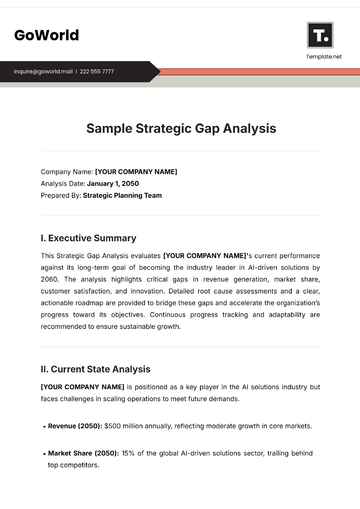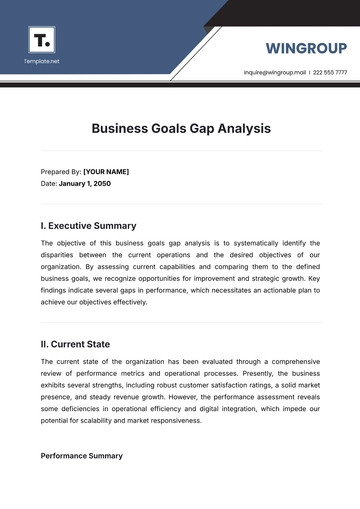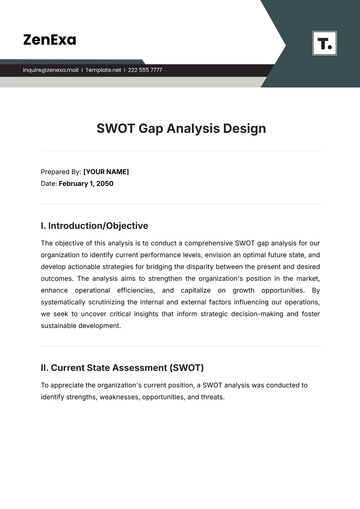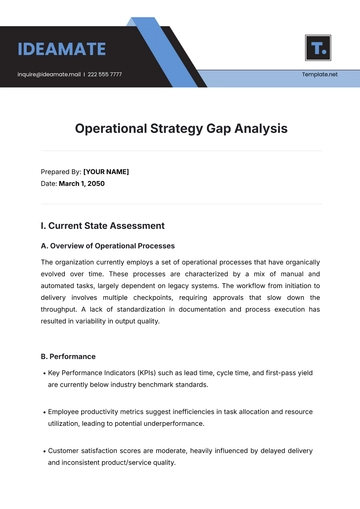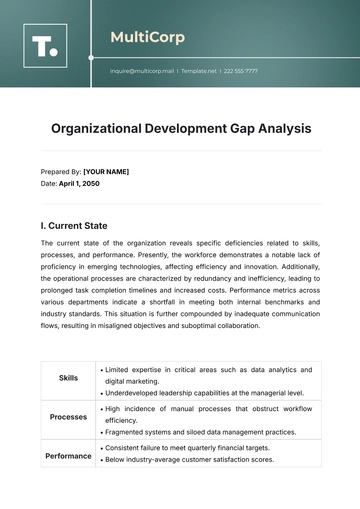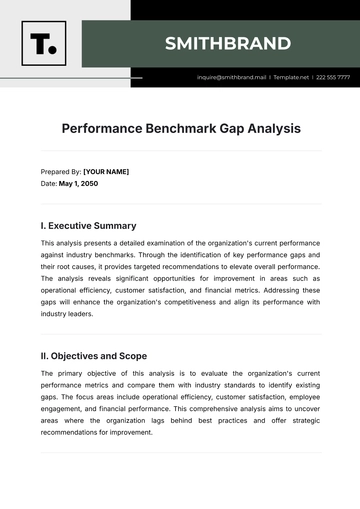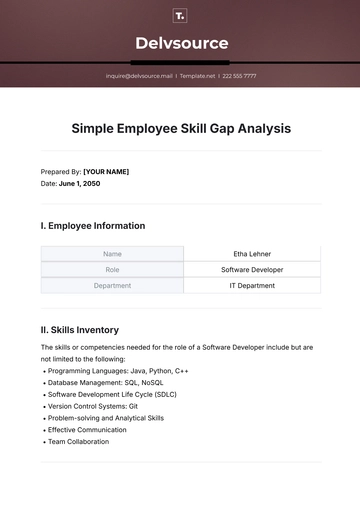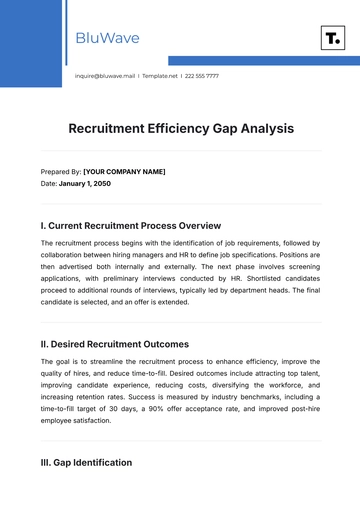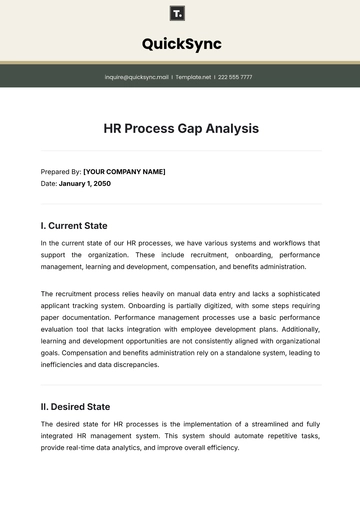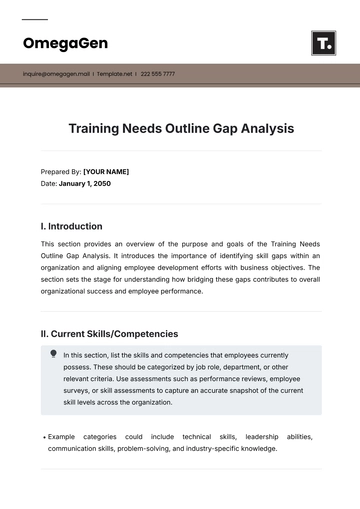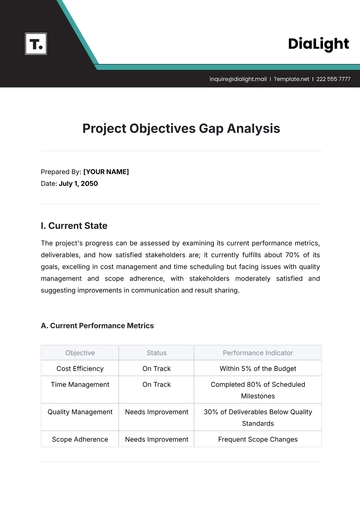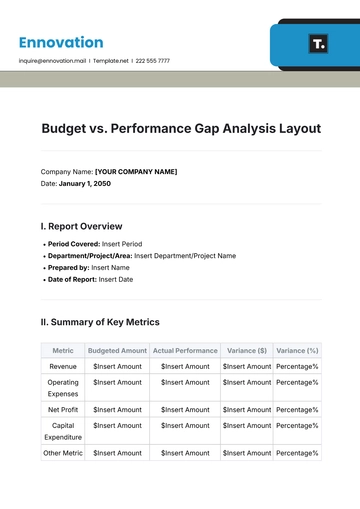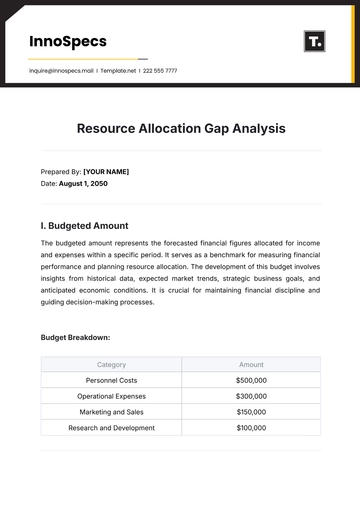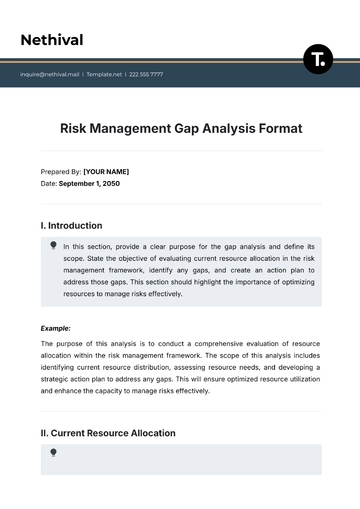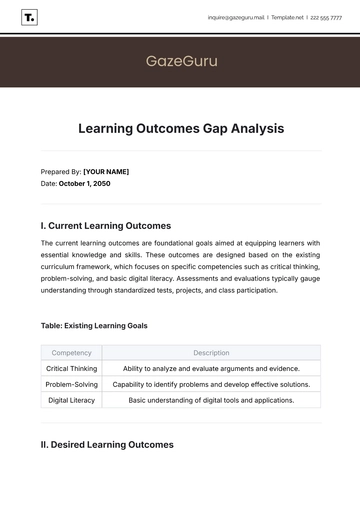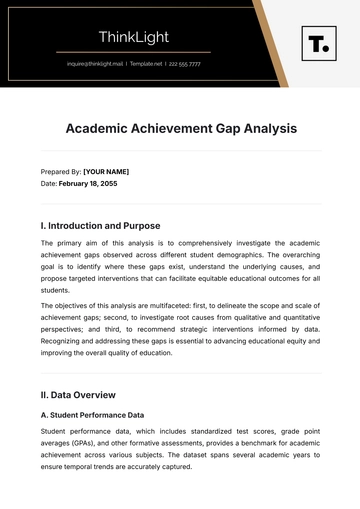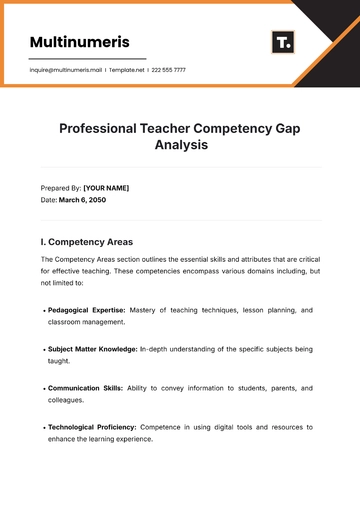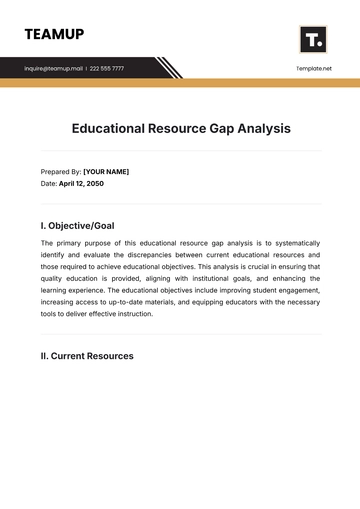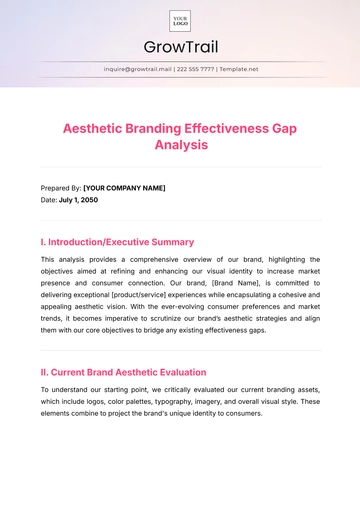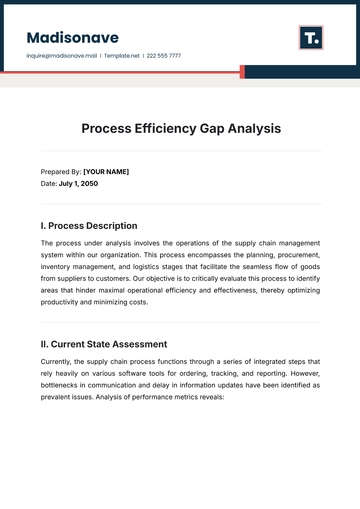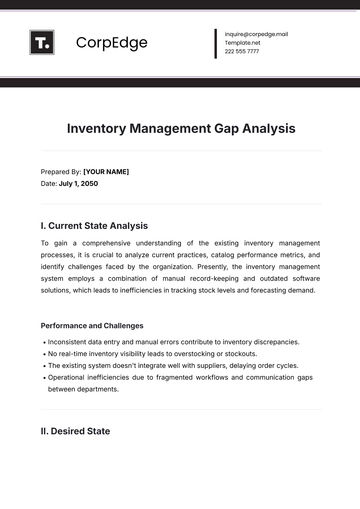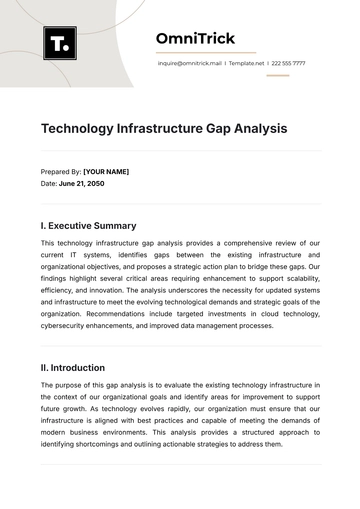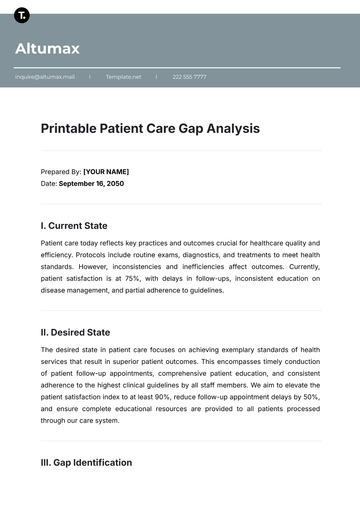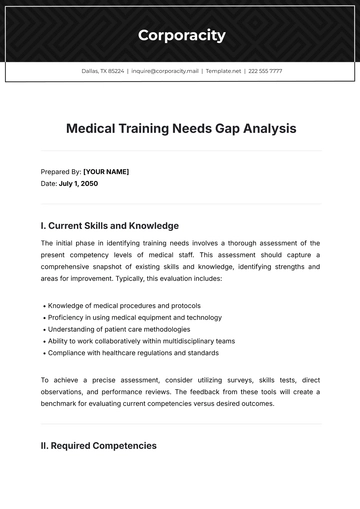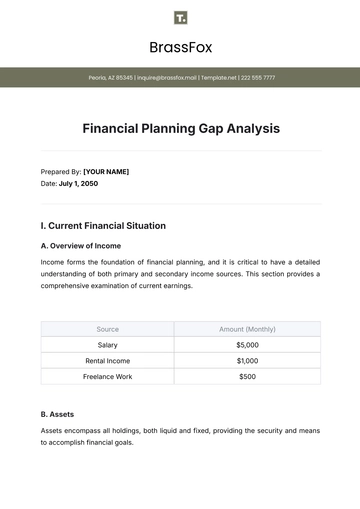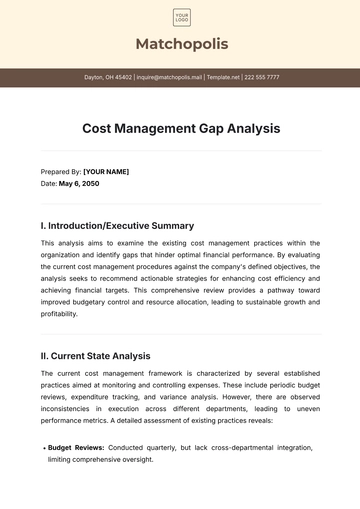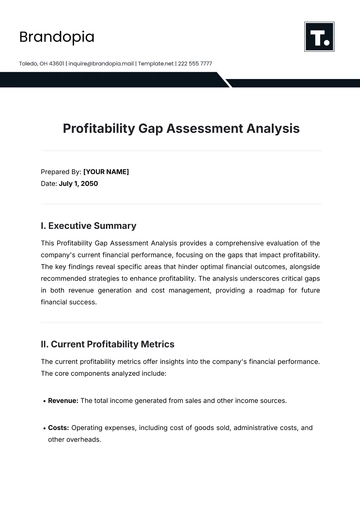Free Education Gap Analysis
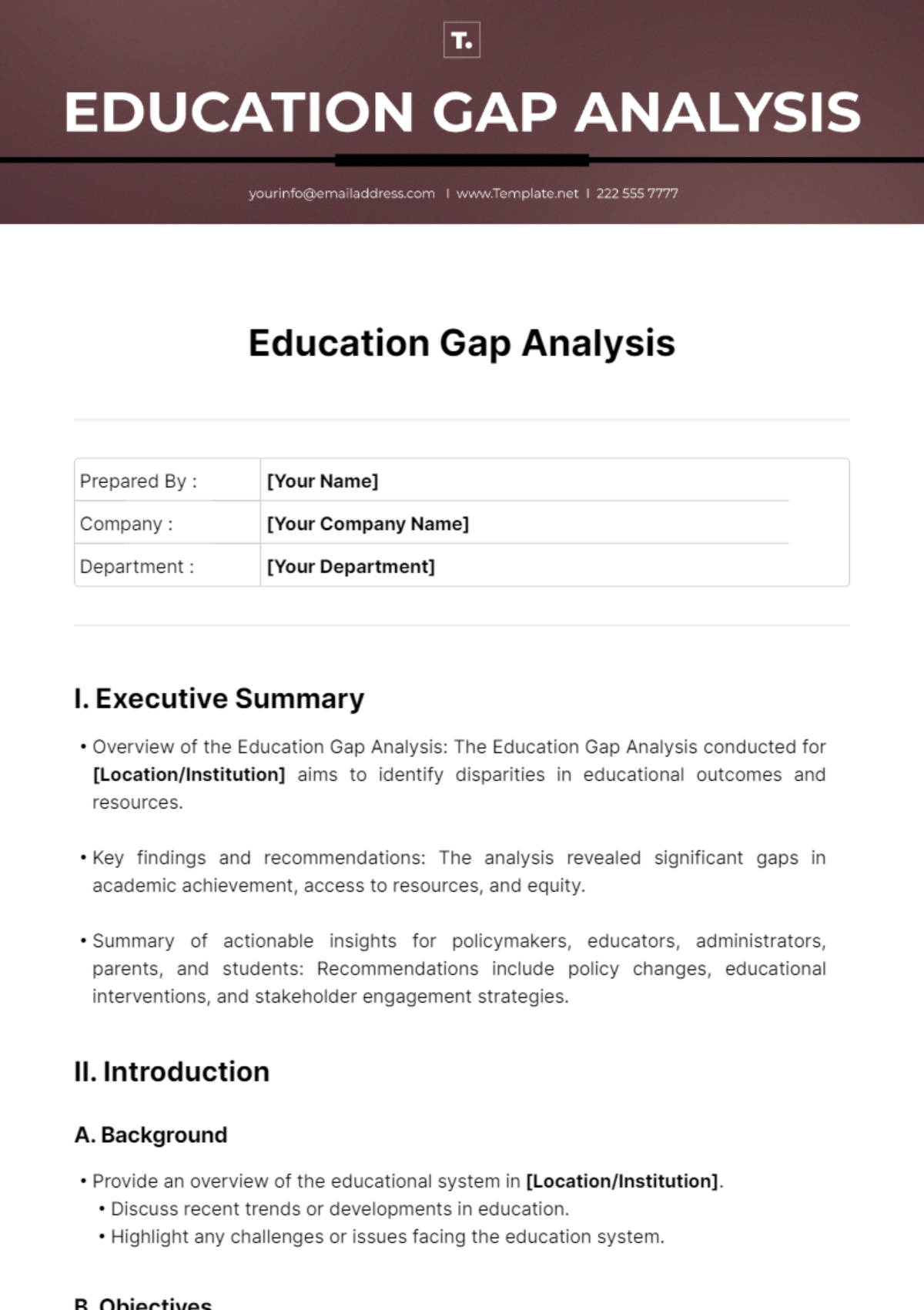
Prepared By : | [Your Name] |
Company : | [Your Company Name] |
Department : | [Your Department] |
I. Executive Summary
Overview of the Education Gap Analysis: The Education Gap Analysis conducted for [Location/Institution] aims to identify disparities in educational outcomes and resources.
Key findings and recommendations: The analysis revealed significant gaps in academic achievement, access to resources, and equity.
Summary of actionable insights for policymakers, educators, administrators, parents, and students: Recommendations include policy changes, educational interventions, and stakeholder engagement strategies.
II. Introduction
A. Background
Provide an overview of the educational system in [Location/Institution].
Discuss recent trends or developments in education.
Highlight any challenges or issues facing the education system.
B. Objectives
A clear statement of the objectives of the Education Gap Analysis: The primary objective of this analysis is to identify and analyze disparities in education to inform targeted interventions and policy decisions.
III. Methodology
A. Data Collection
Sources of data (e.g., surveys, interviews, assessments)
Student performance data from standardized tests
Surveys of educators, parents, and students
Analysis of demographic and socioeconomic data
Sample size and characteristics: The analysis included data from 5 schools across [Location/Institution].
B. Analysis Techniques
Statistical methods used: Descriptive statistics, regression analysis, and gap analysis techniques were employed to analyze the data.
Tools or software utilized for data analysis: SPSS, Excel, and data visualization tools were used for data analysis.
IV. Findings
A. Overall Education Gap
Summary of the identified disparities or discrepancies: The analysis revealed significant gaps in academic achievement, access to resources, and equity.
Highlight key areas of concern: Provide a detailed summary of the identified disparities or discrepancies, including specific data points and trends observed.
B. Specific Gap Analysis
Academic Achievement: Disparities in standardized test scores and graduation rates were observed among different demographic groups.
Access to Resources: Disparities in funding, facilities, and technology access were identified between schools in affluent and low-income areas.
Socioeconomic Factors: The analysis found a correlation between socioeconomic status and educational outcomes.
Equity and Inclusion: Disparities in disciplinary actions and access to advanced coursework were observed among diverse student populations.
Teacher Quality and Training: Disparities in teacher qualifications and professional development opportunities were noted.
V. Discussion
A. Interpretation of Findings
Analysis of the root causes behind the identified gaps: Provide an in-depth analysis of the underlying factors contributing to the identified disparities, including socioeconomic, cultural, and institutional factors.
Discussion of contextual factors influencing educational outcomes: Examine how contextual factors such as community support, parental involvement, and school leadership impact educational outcomes.
B. Implications
Impact of education gaps on stakeholders: Discuss the implications of the identified gaps on various stakeholders, including students, educators, parents, and the community.
Potential consequences if gaps are not addressed: Highlight the potential long-term consequences of failing to address the identified education gaps, such as perpetuating inequality and hindering economic growth.
Demographic Group | Average Test Scores | Graduation Rate (%) |
|---|---|---|
Low-Income Students | 78 | 85 |
Minority Students | 75 | 82 |
Students with Disabilities | 70 | 75 |
VI. Recommendations
A. Policy Recommendations
Strategies for policymakers to address systemic issues: Provide specific policy recommendations aimed at addressing the root causes of the identified education gaps, such as equitable funding policies, inclusive curriculum development, and targeted support for disadvantaged communities.
Legislative or regulatory changes needed: Identify legislative or regulatory changes necessary to implement the proposed policy recommendations, including potential challenges and opportunities for advocacy.
School | Total Budget ($) | Per-Pupil Spending ($) |
|---|---|---|
School A | $500,000 | $10,000 |
School B | $750,000 | $15,000 |
School C | $400,000 | $8,000 |
B. Educational Interventions
Curriculum Development: Recommend strategies for developing a more inclusive and culturally responsive curriculum that meets the needs of diverse student populations, including integrating multicultural perspectives and real-world applications.
Teacher Training Programs: Propose professional development programs to improve teacher effectiveness and cultural competence, including ongoing training in evidence-based instructional practices and strategies for promoting equity and inclusion.
Resource Allocation: Suggest methods for more equitable resource allocation, such as weighted funding formulas based on student need, targeted grants for underserved schools, and leveraging community partnerships to supplement resources.
Parental and Community Involvement Initiatives: Recommend strategies for increasing parental and community involvement in education, including creating welcoming school environments, providing resources for family engagement, and fostering partnerships with local organizations.
C. Stakeholder Engagement
Suggestions for involving educators, administrators, parents, and students in addressing the education gaps: Outline strategies for engaging stakeholders in the decision-making process, including regular communication, opportunities for input and feedback, and collaborative problem-solving approaches.
VII. Conclusion
Summary of key insights and recommendations: Summarize the main findings and recommendations of the Education Gap Analysis, emphasizing the importance of collaborative efforts to address the identified gaps and improve educational outcomes for all students.
Call to action for stakeholders to collaborate in bridging education gaps: Issue a call to action for stakeholders to work together to implement the recommended strategies and monitor progress towards closing the education gaps, emphasizing the shared responsibility for ensuring educational equity and excellence.
- 100% Customizable, free editor
- Access 1 Million+ Templates, photo’s & graphics
- Download or share as a template
- Click and replace photos, graphics, text, backgrounds
- Resize, crop, AI write & more
- Access advanced editor
Introducing the Education Gap Analysis Template, meticulously crafted by Template.net for comprehensive educational assessment and strategic improvement. This customizable document empowers educators, administrators, and policymakers to identify gaps between current performance and desired educational outcomes. With editable features and a user-friendly design, it facilitates tailored analysis to pinpoint areas needing attention, allocate resources effectively, and develop targeted action plans. Streamline your improvement process and gain valuable insights into enhancing student achievement and institutional effectiveness. Elevate your educational strategy with this versatile template, your essential tool for driving academic excellence and closing achievement gaps.

